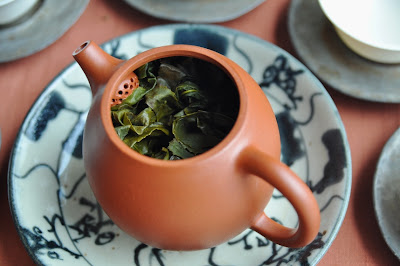Recently, I could repurchase my favorite
Spring 2006 wild, old arbor Lincang raw puerh cake. It had been in my selection for a while and I kept a few cakes for my own pleasure. This provides a good opportunity to compare the storage in my apartment (in northern Taiwan) with the professional storage in a dedicated puerh warehouse (in Taiwan). First, guess which cake comes from where?
The cake on the left looks darker and isn't as tightly pressed as the cake on the right. This is the cake from my home! I had kept it in its tong, in a carton, on top of a closet in a sleeping room where we use the air conditioning the least in summer.
The cake on the right comes from a clean and well managed puerh warehouse. Its appearance is lighter, greener and less shiny. Once a month, the tea is inspected and shuffled around, if necessary. Cases that are high are put below and vice versa...
In terms of smells, my home stored cake has a slightly darker, wood like scent, but also weaker fragrances. The warehouse cake has a much more energetic, pungent, flowery scent. It is much more 'attractive' and sweet.
I brew both cakes side by side, using the same weight (3 grams). The brew of my cake is a little bit darker. But what strikes me much more is the color of the leaves: the warehouse stored leaves are still very green, while my leaves are darker and much more red! This means that my cake partially oxidized during its storage.
In terms of taste, there are lots of similarities that confirm that these are the same puerh. (I started to have my doubts after all these differences!). Also, the taste tended to become more and more similar as I made more brews. But the taste of the warehouse stored leaves has more energy overall. In the first brews it had more depth and balance.
What is good aging of puerh?
From this experience, I conclude that oxidation of the leaves (darker leaves) isn't necessarily a good sign of aging.
What is the difference between my home storage and the warehouse storage?
My puerh occupies a small space in the room, while in a warehouse, the tea is stored in a much bigger quantity. Also, such warehouse keeps its doors shut most of the time. There is less air and airflow.
Another difference is the presence of old raw puerh in the warehouse, while I stored all my old puerh in another room. (This is going to change...) The inoculation of the young puerh with bacteria from older leaves probably also helped to improve the young puerh. Despite the leaves looking greener, it didn't feel/taste younger than the darker leaves from my storage.
The outstanding quality of this raw puerh can be seen in the clear, transparent and shiny brew. It is amazing how pure and powerful its taste can be. Despite the competition style brew (3 grams for 6 minutes), the mouth remains perfectly clean. All that remains is an extremely refined and powerful cha qi and never-ending aftertaste.
 |
| It's so amazing, it has a scent of rose when brewed well! |
The expression 'teamaster' takes a new meaning with these leaves: the tea is the master! You learn how to define and measure quality with such a tea. Purity, energy, clean feeling, sweetness, warmth... It has it all.
This raw puerh sets the bar very, very high. The best education comes from the study of the classics (*). These spring, high elevation, old arbor, wild puerh leaves are a masterpiece of puerh. I'm very glad that I can add this (warehouse stored) cake to my selection again.
(*) The best motivation to learn is also to enjoy the 'material'!









































